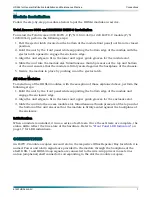
HDSL4 for General Distribution Installation and Maintenance Practice
HDSL4 System Testing
61223HDSL4L2-5C
13
Provisioning Options, Total Access 3000 H4TU-C
The Total Access 3000 H4TU-C is provisioned through the SCU on the Total Access 3000
chassis. In addition to the options shown in
on page 11, the options shown in
apply.
HDSL4 SYSTEM TESTING
The ADTRAN HDSL4 system provides the ability to monitor the status and performance of the
DSX-1 signals, DS1 signals, and HDSL4 loop signals. Detailed performance monitoring is
provided by the front panel-mounted RS-232 control port. These features are valuable in
troubleshooting and isolating any system level problems that may occur at installation or
during operation of the HDSL4 system. Additional testing features are described below.
H4TU-C Bantam Jacks
The front panel of an H4TU-C module contains both metallic splitting (
EQ
) and monitoring
(
MON
) bantam jacks.
The
EQ
jacks provide an
intrusive
access point, interrupting signal access to the local loop.
This provides a port for the test set to transmit a test signal toward an H4TU-R module and to
receive a test signal from an H4TU-R module.
Table 7. Total Access 3000 Additional Provisioning Options
Provisioning Option
Option Settings
Default Settings
Service State
1
In Service, Out-of-Service Unassigned,
Out-of-Service Maintenance
Out-of-Service
Maintenance
Network Source
2
DSX, MUX A, MUX B, Auto MUX
DSX
External Alarms
Enabled, Disabled
Disabled
Auto In Service
Disabled, Enabled
Enabled
Auto IS Startup Period
1 hour, 4 hours, 8 hours, 24 hours
4 hours
Auto IS Off Period
1 hour, 4 hours, 8 hours, 24 hours
8 hours
1. The Service State defaults to Out-of- Service Maintenance, which allows active connections to the DSX or
MUX interface; however, no alarms are generated. The In Service setting allows full functioning connections to
DSX or MUX interfaces. The Auto In Service option must be changed per Local Work Instruction to put the
unit in service. Out-of-Service Maintenance allows the loops to train up but does not pass data to the DSX or
MUX interface.
2. For Network Source settings, the following options apply:
•
DSX-1
: The module utilizes the DSX-1 interface. The Muxes are not used, even if present.
•
Mux A
: The module uses Mux A as its data source. The module does not switch to Mux B in the case of a Mux
A failure. The EQ jacks can be used as a temporary test point in conjunction with the EQ jack setting on the
loopback/test screen.
•
Mux B
: The module uses Mux B as its data source. The module does not switch to Mux A in the case of a Mux
B failure. The EQ jacks can be used as a temporary test point in conjunction with the EQ jack setting on the
loopback/test screen.
•
Auto Mux
: The module defaults to Mux A as its data source. In the event of a Mux A failure, the module
performs a protection switch to Mux B if it is present and in service. The EQ jacks can be used as a temporary
test point in conjunction with the EQ jack setting on the loopback/test screen.
















































